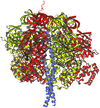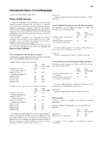issue contents
November 1998 issue

Cover illustration: Selected element-specific X-ray fluorescence images of a hydrated P. lanceolata root infected by the mycorrhizal fungus G. mosseae, recorded at the Advanced Photon Source, USA, see Yun, Pratt, Miller, Cai, Hunter, Jarstfer, Kemner, Lai, Lee, Legnini, Rodrigues and Smith, pages 1390-1395.
facility information
editorial
Free 

obituaries
Free 

research papers
The construction status of the world's smallest electron storage ring is described. The expected FIR output is of the order of 100 W. Bremsstrahlung is used instead of synchrotron radiation to generate hard X-rays, whose brightness exceeds that of a rotating-anode source by about 1000 times or more.
An X-ray linear-array detector was fabricated from CdZnTe. The detector was developed for applications utilizing high-energy X-rays. An energy resolution of 5.8% was obtained at 122 keV.
A test of the focusing optics on a bending-magnet beamline at the ESRF for coherent SAXS experiments is described, and a comparison between the calculated and measured degree of coherence is given.
A description and characteristics of the mirror–two-crystal–mirror point-focusing monochromator installed on beamline D2AM at the ESRF for MAD, DAFS, SAXS and WAXS experiments are given.
The main characteristics of a new type of X-ray beam are presented. Diffraction of X-rays by a pulsed surface acoustic wave is used to perform a flexible high-frequency selection of synchrotron radiation pulses.
An ultrahigh-vacuum reaction apparatus to study synchrotron-radiation-stimulated process has been constructed and placed on beamline 4B of the synchrotron radiation storage ring (UVSOR). The apparatus is equipped with IR reflection absorption spectroscopy (IRRAS) and reflective high-energy electron diffraction (RHEED) systems for in situ observations.
Intensity profiles have been collected from three-beam interference experiments with radiation both from a conventional X-ray source and from two synchrotron sources. The interpretability of these profiles with respect to phase information is strongly affected by the beam divergence and different scan modes.
A numerical technique for relating imaging-plate intensities to absolute incident X-ray count rates is demonstrated. No additional calibration detectors are required as all the information is obtained from the intensity distribution of the recorded image.
A new approach to computing a temperature-dependent anharmonic correction to EXAFS is described.
An X-ray microscope with high spatial resolution and high elemental sensitivity has been developed.
short communications
An energy-dispersive polychromator set-up enabling XAFS experiments between 5 and 25 KeV is presented. The system intergrates three rotation axes, vacuum compatibility, cooling and three degreees of freedom for the crystal bending.
international union of crystallography
Free 



 journal menu
journal menu


































